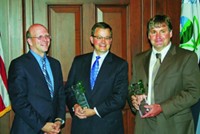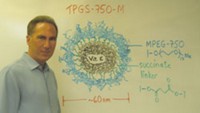Advertisement
Grab your lab coat. Let's get started
Welcome!
Welcome!
Create an account below to get 6 C&EN articles per month, receive newsletters and more - all free.
It seems this is your first time logging in online. Please enter the following information to continue.
As an ACS member you automatically get access to this site. All we need is few more details to create your reading experience.
Not you? Sign in with a different account.
Not you? Sign in with a different account.
ERROR 1
ERROR 1
ERROR 2
ERROR 2
ERROR 2
ERROR 2
ERROR 2
Password and Confirm password must match.
If you have an ACS member number, please enter it here so we can link this account to your membership. (optional)
ERROR 2
ACS values your privacy. By submitting your information, you are gaining access to C&EN and subscribing to our weekly newsletter. We use the information you provide to make your reading experience better, and we will never sell your data to third party members.
Environment
Presidential Honors Awards
Awards recognize innovations that promote sustainability
by Stephen K. Ritter
June 29, 2009
| A version of this story appeared in
Volume 87, Issue 26

Cleaner, cheaper, smarter chemistry. That has become green chemistry's tag line. And nowhere is it better exemplified than in the chemical research and emerging technologies put forward by the winners of the Presidential Green Chemistry Challenge Awards.
This year's honorees were recognized for their achievements at a ceremony held on June 22 at the Carnegie Institution for Science, in Washington, D.C. The event served as the kickoff for the annual Green Chemistry & Engineering Conference, which is taking place on June 23–25 at the University of Maryland, College Park.
American Chemical Society President Thomas H. Lane, speaking during the ceremony, observed that the awards "pay tribute to the ingenuity of chemists and the commitment to our professional code of conduct. Part of that code states that we should understand and anticipate the environmental consequences of our work and that we have a responsibility to prevent pollution and to protect the environment."
The awards program, administered by EPA and sponsored in part by ACS, provides national recognition for incorporating the principles of green chemistry and engineering into the design, manufacture, and use of chemical products to help achieve federal pollution-prevention goals and promote sustainability.
Among the 2009 award winners is Carnegie Mellon University chemistry professor Krzysztof Matyjaszewski, who received the Academic Award for developing atom-transfer radical polymerization techniques that use small amounts of a copper catalyst in conjunction with environmentally friendly reducing agents or radical initiators. This research has opened up greener routes to advanced polymeric materials.
Virent Energy Systems, Madison, Wis., garnered the Small-Business Award for its BioForming refinery process, an efficient aqueous-phase catalytic method to make biofuels and chemicals from plant sugars, starch, or cellulose.
Eastman Chemical landed the Greener Synthetic Pathways Award for developing a biocatalytic process to convert plant-derived fatty acids into long-chain esters for use as emollients and emulsifiers in cosmetic and personal care products.
CEM Corp. of Matthews, N.C., took home the Greener Reaction Conditions Award for its Sprint Rapid Protein Analyzer and iTAG labeling chemistry, which permits users to selectively label proteins with an azo dye for colorimetric total protein analysis of foods without generating hazardous waste.
Procter & Gamble and Cook Composites & Polymers teamed up to win the Designing Greener Chemicals Award for creating Chempol MPS alkyd resin technology, which uses a sucrose ester made from sugar and vegetable oil as a combination solvent-resin that significantly reduces the amount of volatile organic compound emissions from oil-based paints and coatings.
"This year's award-winning technologies represent the very best that green chemistry accomplishes," commented James J. Jones, acting assistant administrator of EPA's Office of Prevention, Pesticides & Toxic Substances, which houses EPA's Green Chemistry Program. They are not only examples of new enabling chemistry that will prevent millions of pounds of hazardous waste from being formed, Jones added, but also examples of "doing it right the first time."
The 2009 Kenneth G. Hancock Memorial Student Awards in Green Chemistry, sponsored by the ACS Division of Environmental Chemistry and the National Institute of Standards & Technology, were also presented at the ceremony. This year's recipients are Johnathan T. Gorke of the University of Minnesota, Twin Cities, and Joseph B. Binder of the University of Wisconsin, Madison. Each award consists of $1,000 and a certificate and is named in honor of Hancock, an early proponent of green chemistry who died unexpectedly in 1993 during his tenure as director of the National Science Foundation's Chemistry Division.
Gorke was lauded for his research with biochemistry professor Romas J. Kazlauskas on enzyme-mediated syntheses carried out in deep eutectic solvents, a type of ionic solvent that can be made from renewable materials and serve as an alternative to organic solvents or ionic liquids. Binder was singled out for his research with chemistry professor Ronald T. Raines on transforming cellulosic biomass into fuels and chemicals and on aqueous-phase olefin metathesis reactions.
"Green chemistry education is critical to the development and adoption of cleaner products and processes, and research advisers play a central role by instilling an environmental ethic in their students," said Madeleine Jacobs, ACS's executive director and CEO, who presented the awards to Gorke and Binder.





Join the conversation
Contact the reporter
Submit a Letter to the Editor for publication
Engage with us on Twitter